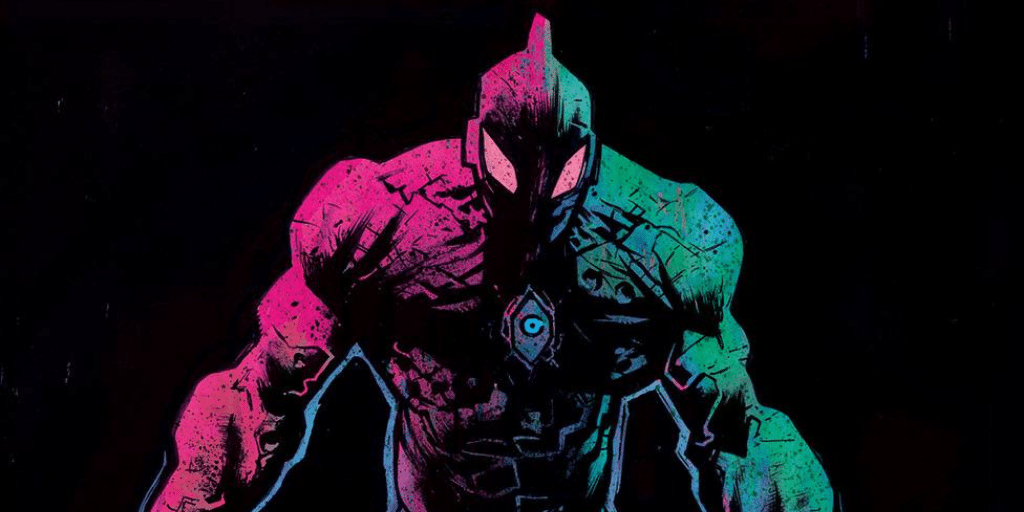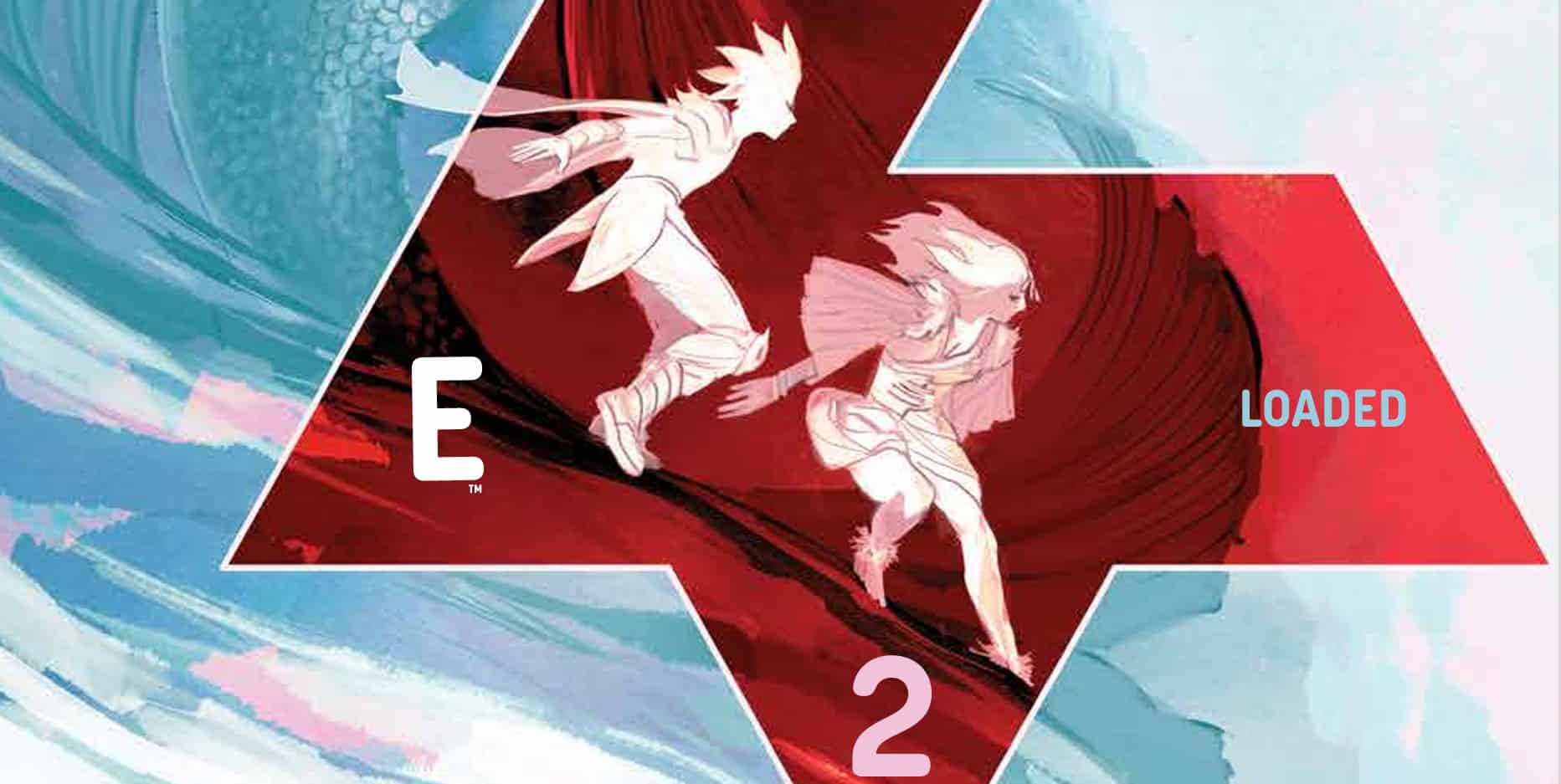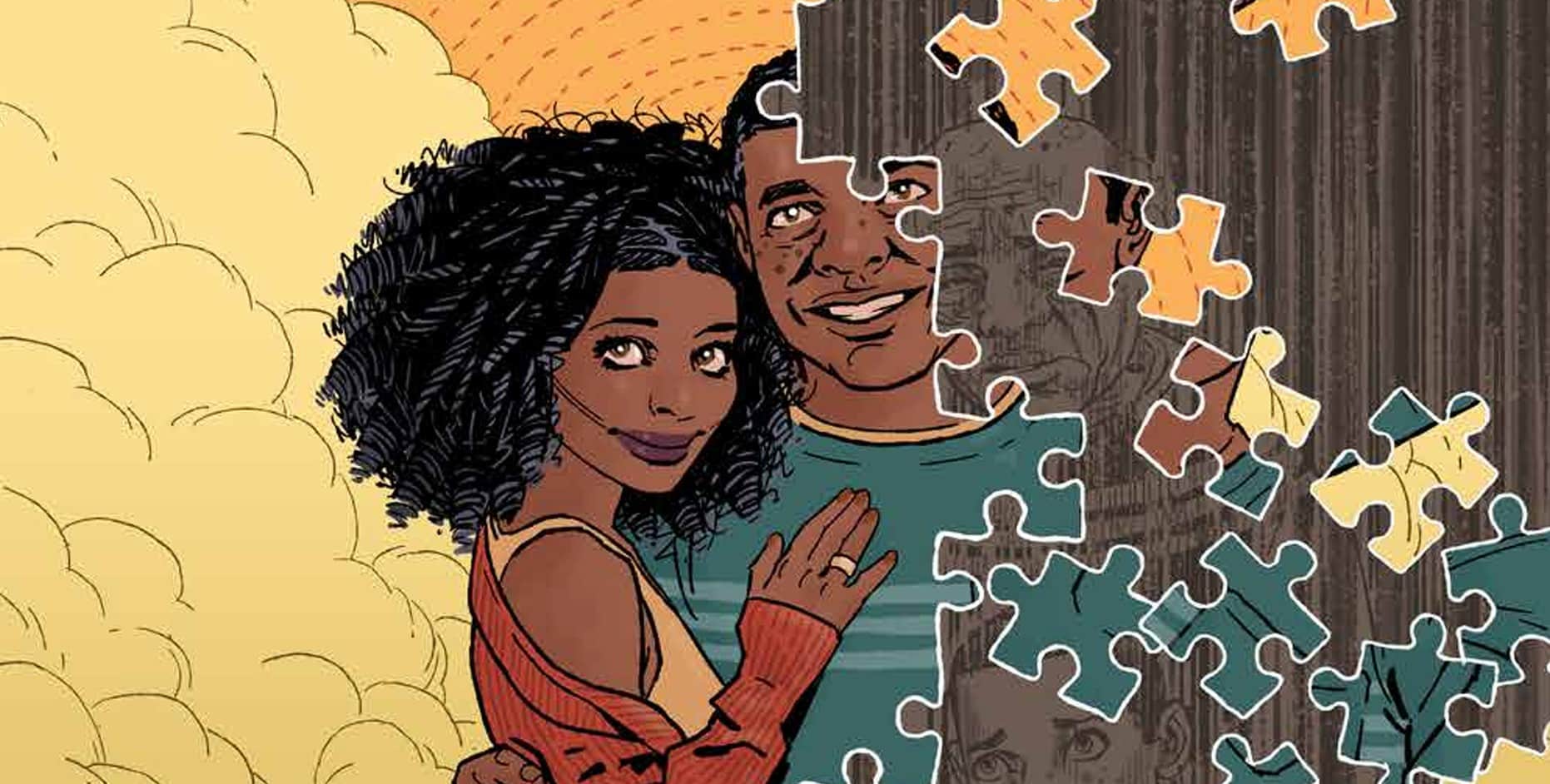A cosmic plague has spread, transforming everyday people into violent, monstrous kaiju. Only the Ultramega, three individuals imbued with incredible powers, hold the line against this madness. Their battles level cities and leave untold horror in their wake. Now, the final reckoning approaches for the Ultramega, but is this a war they can even win? Fight monsters and stand with humanity in this new Image series from James Harren and Dave Stewart.
Ian Gregory: There’s been a lot of toku stuff lately, right?
Ritesh Babu: Absolutely. It’s kind of ridiculous if you think about it, all just kind of … converging like this.
IG: I’m definitely not complaining, but I do think it’s funny that within the span of a year we’ve had at least three new toku-inspired comic series. Fortunately, they’re all distinct and interesting in their own ways.
RB: And this one is probably, dare I say it, the biggest launch of them all? It’s by James bloody Harren of all people, who’s inspired so many artists after him. It’s over 60 pages as a debut, like a goddamn Shounen manga in JUMP! And each subsequent issue is going to be a minimum of 40 pages. It’s a book REALLY committed to delivering on its title. ULTRAMEGA indeed.
IG: It feels exactly like the first chapter of a new Weekly Shonen Jump manga. I’ve stayed away from most of the pre-release info around this series, so I was surprised and delighted that this first issue is essentially a gigantic prologue for the rest of the series. I think the expanded page count really suits the book.
RB: That was definitely my takeaway finishing it. And I do mean that in the best possible sense. It reminded me of those meaty shounen debuts I read as a kid and was just blown away by. There’s this sense of a whole world, the suggestion of all yet to come, packaged in high-octane, dynamic action of incredible bombast. This is a #0 disguised as a #1, but that’s a good thing. It feels like you’re on the edge of something humongous.

IG: The page length is definitely helped along by Harren’s willingness to just throw splash pages at us. The fights in this series are definitely supersized, and I think the huge layouts help convey that feeling. Don’t be scared by the length — I ripped through this in no time, and felt compelled to give it another read-through right after. What do you think about the first few pages — the classic “bargain with an extradimensional being that grants you the ability to grow in size to fight giant monsters?”
RB: That really worked for me, especially as a tease. We know so little about the Ultramega as things stand. But as a sampler of what it is they are, and what we can expect, that was tremendously fun. We don’t know how real that scene is, or what the true nature of anything is, as of yet. And that’s kind of what’s deeply exciting with this book for me? That’s why I invoked shounen and being a kid again. This is a debut comic I read over and over, one wherein every expectation I held fell away, and something new lay hiding at the end. The sense of “discovery” here is thrilling. It’s maybe one of the best Image #1s I’ve ever read period?
IG: It’s definitely in contention with Giga for most exciting #1 of recent memory. I think you’re right about the feeling of discovery, but it’s still familiar. I’m tempted to point out everything I see in this book that reminds me of something else — that’s Ultraman, that’s Jagaaaaaan, that’s Devilman, and so on (Harren even acknowledges the Devilman connection in his statement at the end). But, despite all these genre tropes and familiar elements, Ultramega is still its own work. And despite its genre and anime/manga influences, it still feels like a James Harren, American comic book, not like someone playing at manga.
RB: The Devilman connection in particular is fascinating to me, because not only is Go Nagai the creator of the super-robot/mecha genre, but also the post-apocalyptic genre in comics with Violence Jack. So the idea of taking Ultraman and doing it by way of Go Nagai is … kind of fascinating. And it works, I have to say!
IG: I’m an established Nagai fanatic, who also helped pioneer the magical girl genre with Cutie Honey, and as we all know, the magical girl genre is structurally identical to tokusatsu. Nagai loved ultraviolence, the apocalypse and broken families (and this guy wrote for a kids’ magazine!), so I think that influence really shines here in Ultramega. I really respect that Harren spent so much time endearing us to these characters and the little details of their lives, before killing all of them and flipping the table over. I think it would have been much easier to just gloss over the pre-apocalypse stuff, but this way is better. It gives us a real stake in what it means to be an Ultramega, as well as a personal perspective to see how the world has changed.
RB: A creator more obsessed with economy might have, indeed, opted for efficiency and opened with the legacy kid, as exposition of the past unraveled. But this is NOT a comic about economy or efficiency, which I don’t intend as a knock on it. It’s a comic of the manga tradition. It’s sprawling battles, incredible double-page spreads and splashes. It’s a comic about energy. It’s about scope, scale and ultimately power. That’s what Harren wants to communicate. This is a mission statement. This opener is a promise.

IG: The fights definitely deliver on that promise. They’re kinetic, for all their size, and extremely bloody. I like the mixture of classic (Ultra! Mega! Beam!) and modern (the force of their blows knocks nearby pedestrians out). I’m less enthusiastic about the gore. As a kid, discovering these comic books in the local library that were full of violent fights and intestines was like a forbidden thrill, a far cry from my grandfather’s Silver Age DC books. Over time, that thrill has faded, and while I don’t hold ultraviolence against any book, it no longer does much for me. All that said, having the river of blood from an Ultramega’s corpse flood the city streets was a stroke of genius.
RB: I think I’m of a different mind here. I think perhaps the defining image of the entire book is the impaled Ultraman on a tower, with his intestines visible. It’s kind of the whole enterprise in a nutshell. That gore, that body horror and brutality, that’s, again, to me, part of drawing on something like Devilman. Go Nagai absolutely loved his blood and gore, and while seeing it applied to the imagery of the Ultras is … kind of horrific, it is the point in a way that’s working for me? Certainly, it’s the kind of thing I think Nagai might have gotten a kick out of. It’s kind of sacrilegious in a way, but that’s kind of what this is. It’s signalling, “This is this kind of book.”
IG: You’re definitely spot-on about the impalement panel. I kept coming back to it in a morbidly fascinated sort of way. And I think you’re right, too, that there’s a reason for the gore. This isn’t a Garth Ennis comic; Harren is doing this with purpose and intentionality. The violence isn’t just in the book “because it’s dark and gritty” but because Harren appears committed to a body-horror reading of the Ultraman transformation. Ultramega aren’t filled with cosmic energy but with blood and guts. I think that’s the core message of this first issue, with its focus on the sad, confined lives of the men consigned to waging eternal war against the kaiju.
RB: And certainly, this isn’t the first “brutal” Ultraman take to emerge, as there have been many over the years, including and especially Redman. But it is perhaps the most contemporary and distinctive? Like, this is a comic that opens on a society plagued by a virus, coming out during the pandemic. It’s a comic that seems to open on a typical Ultra-pastiche in the Ultramegas, but then performs narrative substitution by revealing this is not their story. It’s about the story of those who come after. It’s about the boy in an apocalypse where mankind has stopped believing. It’s the story of what comes next after The Fall of Ultra.
IG: Also, rather than being unrelentingly grim and despairing (I just learned the term utsumanga, for manga whose genre is “depressing”), this issue ends on something of a hopeful note. This junker character proudly declaring they “stand with the Ultramega” feels more like an embrace of Ultraman’s ethos (someone we talked about quite a bit in our discussions of the Marvel Ultraman series) than a rejection. That’s an interesting tone to strike: sad, violent, post-apocalyptic and despairing, but not hopeless.
RB: Yeah. This is a comic about brutal physicality. It’s about the flesh. It’s about infections and pus and your body popping with all manner of bizarre things you cannot control. It’s horrific and weird and rolling in that bloody, messy, dirty physicality of humanity. But, like you said, amidst all that dirt, at the heart of our own apocalypse, as the Earth and mankind lie decaying, there is hope. There is faith. There is belief in something greater.

IG: I am a sucker for body horror, and this issue is definitely gross in all the right ways. I think there’s something in the way that, after the failure of the Ultramega (and we never do find out what was happening to the kaiju they were fighting), mankind pivoted toward mechanical guardians (despite, again, there not being a single kaiju event in this post-Ultramega era). I have so many thoughts and questions on this: Were the Ultramega causing the virus outbreaks in the first place? What do we make of mankind’s collectivist turn in their embrace of the robots (and therefore, rejection of this alien power of the Ultramegas)? How about that eye motif on the robots?
RB: The eye motif! I want to note, Harren also takes the iconic Color Timers of the Ultras and turns them into weird, fleshy, organic Eyes. And by the end, when the last Ultramega sends away his Timer/Eye, it’s almost like … a Green Lantern ring being sent away by a dying Lantern. There’s so much going on here.
And yeah, the mystery of the Ultramega, the idea of them potentially being just the other end of the same coin as the Kaiju, that was super interesting. It’s a massive change, because Ultraman can just … become Ultraman. Ultramegas CANNOT. They cannot only transform when in proximity to the kaiju, to the virus. They are defined by their relationship to violence, in effect, which, again, there’s horror in that.
IG: I suppose we do see that it’s possible for a kaiju to manifest without an Ultramega — that’s what allows Jason’s kid to become so large and powerful (though I find it suspicious that our only example of this is of people who spent time in close proximity to an Ultramega). Maybe we’re on a timer before the virus starts manifesting all on its own, and there’ve been many great and powerful threats incubating in the decade or so since the prologue. It would certainly make a good explanation for how there have been so many years of relative peace — more convincing than these scaled-down mechs, at least.
RB: For sure. The big thing that I keep coming back to, which you touched on, is the mechas developed by humanity, the Titans. The root of the mecha/super-robot genre for me, the almost thesis statement behind the whole thing, is the words Go Nagai wrote ages ago in Mazinger Z:
“If you obtained power beyond your wildest dreams…then how would you use it? Do you use it to become a devil who would destroy the world? Or, perhaps, you would become a hero who would save the world from any peril?”

The mecha/super-robot can be either the divine or the devil for mankind. And here, the idea very much seems to be that, rather than representing progress and self-empowerment of humanity, it represents a regression. A loss of faith in the self, in man, paving the way for absolute submission to technological forces. It’s the organic, the flesh, the nature falling away to the cold metallic exteriors of technology. The conflict of man and machine, organic vs. synthetic, that feels baked in and vital to the text.
IG: There’s something very Getter Robo (to get even more Go Nagai works involved here) in the setup of this series, too. In Getter, the titular machines are used to fight off body-horror styled invaders who seek the destruction of Earth (and sometimes succeed). Getter Robo is in some ways the dark counterpart to Mazinger Z, as it imagines mecha pilots as people who are both heroes and villains, given a noble cause but fighting a bloody, unending war.
RB: Ooh, Getter’s a fun pick, and another essential one, to be sure, given its place as the first “unification” mecha/super-robot series. It’s not just one person. It’s a collective. And that’s where we begin here, with a collective of soldiers fighting a war. But then they fall, and the human collective is removed and replaced, for pure synthetic super-robots, run by the will of no pilots, but the programming instructions of the elite.
IG: Mecha, toku and magical girl are all genres that deal in essentially the same premise. By some means, be it mechanical, alien or magical, a single human is endowed with a great deal of power they access via some sort of transformation. This means that all three series often deal with issues of body and agency. Seeing toku give way to mecha is an excellent way of using this body metaphor, blending the genres to highlight where they overlap. The blood of an Ultramega floods the city, so mankind turns to the safe, sterile world of the mechanical. But what price is there to pay in the transformation into the mechanical?
What distinguishes mecha is in the way that its empowered-human-form is constructed and built, rather than granted. Mecha series are often burdened by capitalism: militaries, police departments or corporations build these mecha, and they are often used to the ends of these organizations. Gundam often questions the motives and methods of the builders of mobile suits, but never has it gone fully into imagining an alternative system; a people’s mecha.
RB: And again, lest we forget, mecha is a vital part of tokusatsu. Ultraman’s long had mecha-aides, and Godzilla’s had everything from Mechagodzillas to Jet Jaguars. So it’s a natural fit here, but placed firmly at odds. The Titans are technological terrors, with an ever-watching eye, representing a dystopian police state. And there’s the sense of the organic being called back into the fold. Humanity needs someone like them to aspire to. Code won’t save the world, for code cannot change hearts. Only people can do that. Only an Ultramega can.
We’ll just have to find out how hard that’ll be, as the ride continues next month!
IG: I’m definitely looking forward to it!






